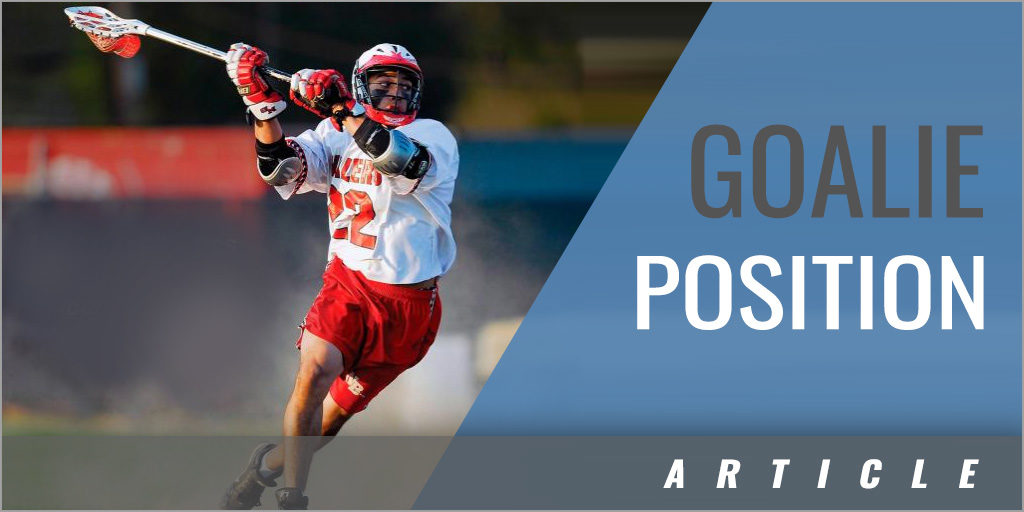|
By: Jack Kaley and Rich Donovan Originally Published in: Lacrosse Essentials Provided by: Human Kinetics The goalie position is pivotal to success in lacrosse. The ability to stop shots by making saves, to lead the defense, and to communicate to teammates will contribute to successful goalie play. Teaching Fundamentals A strong execution of the fundamentals of goalie play are crucial for success in this vital position. Work on basic skills at the beginning of practice. These skills include body and stick positioning, proper footwork, and lower- and upper-body movement. Many coaches work with the goalie without using the goalie stick to emphasize fundamentals. Instructions to the goalie should be clear and concise. Keep it simple, focus on fundamentals and good habits, and be active in the prepractice warm up, which is an important teaching time in each session. Spend a minimum of 15 minutes with each goalie if possible. Introduce proper techniques, reinforce prior learning, and provide feedback. The first area for instruction is proper positioning in the crease area and between the pipes. Foot positioning should be balanced and set to anticipate every shot. The crease is the area encircling the cage occupied by the goalie. Always step to the ball first with the ball-side foot. The lower-body movement creates the upper-body and stick movement that follow. Constantly reinforce stepping to the ball. Hands should be placed so that the top hand is near the throat of the stick and the lower hand grasps the area near the bottom end of the stick. Always keep the stick in front of your body and be ready to react to ball movement from a pass, feed, or shot. The head of the stick should move through the ball when attempting to make the save. Your head should be on every pass, feed, or shot to create the movement of seeing the ball into your stick. This is important on both high and low shots. Begin with a discussion of proper foot positioning: Be set and balanced for the shot, move into each shot by playing the ball aggressively, step to the ball, be in the path, and stay and move through the ball. It is important to know where you are in relation to the crease area and the goal. Use the pipes of the cage as a reminder of where you are as you move to the ball location. The semicircle (3 feet from the front in relation to the pipes) allows you to move to the ball location. The cage is always stationary, allowing you a constant reminder of your position and the proper angles to play. After setting the position of the lower body by balancing your weight heel to toe, keeping your head up and back straight, you should move on to proper hand location by placing your top hand near the throat and your bottom hand near the butt end of the stick. Check stick and hand position before each shot and maintain it into and through the shot. Keep your stick head facing the shooter, with the top hand at the head. Your hands and stick should be out in front of your body and move through a full range of motion. The next area to address is your head. Stay on every shot, and the body will follow the head: Stay behind, beside, or over the ball. Do not let the ball play you, and always be aggressive toward the shot. Play the ball in front, and step to the ball moving your feet and body into the path of the ball. Keep proper positioning at all times. Be set, hold position, and react on the release of the ball. Keys to Proper Technique These are the three key areas for beginning players to concentrate on: Step with the foot to ball side and use the correct foot to the correct side, keep the stick out in front at the proper height and the head flat to the shooter, and always move the feet forward to the shot location. Blocking Passes to Deny Scoring Opportunities The goalie can help reduce the number of shots that will reach the cage. By maintaining proper body and stick position, he can block feeds from behind and across the cage. Properly turning by pivoting the head first so it turns faster than the body and pivoting hard on the inside foot, the goalie can anticipate the feed and ball location and stop the shot. Controlling the Crease Area The crease area protects the goalie and his domain. Communication to defensive players when the ball is on the ground or in the crease area can prevent a potential scoring opportunity. The goalie must aggressively play all loose balls and unsettled action around the crease area. Teach this by reviewing the proper techniques for a check-sticks call, which instructs all defensive players to check their opponent's stick or to body-check by screening and giving the goalie a clear path to pick up the ball. The 7v6 advantage in favor of the defense should allow control and possession of the loose ball by the goalie. Outlet Passes The ability to clear the ball quickly after a save or defensive possession provides a dangerous offensive weapon. This is accomplished by gaining control of the ball. On making a save, the goalie should immediately look up the field to the wing areas or to the defensive corner of the field. The goalie uses the allotted 4 seconds of crease time to survey the situation and let the play develop. He moves within the crease area with possession to create a clear field of vision and create a favorable position for the pass. He does not force the ball into a crowded area, which could result in a turnover. He wants to put the right touch on each pass, avoid throwing too long or too short, and use practice time for outlet passes. If no safe outlet pass is available, the goalie should move behind and out of the crease area to restart the play. Communication Skillful communication must be mastered to attain success in the goalie position. Goalies should be constant and consistent in all calls, practice communication as a positional skill, speak loudly and clearly with authority, be specific and precise, and always be positive and constructive. Key points to communicate include ball location, matchup, backup, and potential and defensive slide. Goalies call check on feeds and passes and must be able to initiate clearing patterns. |







